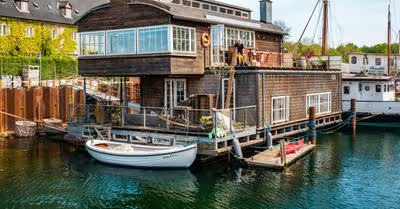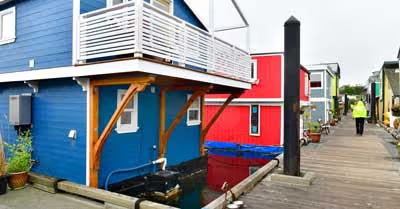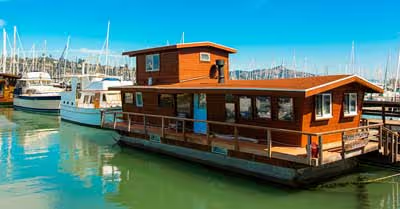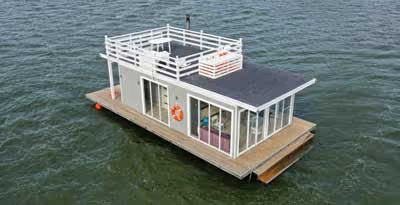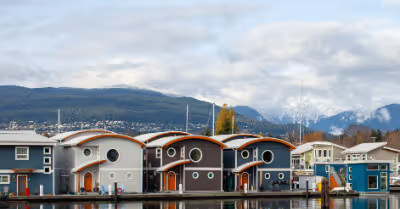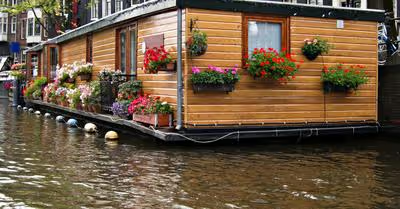
Houseboats look top-heavy and boxy and contain lots of heavy appliances. So how do they manage to float so easily?
Houseboats float because of their flat hulls, wide footprint, and surprisingly low center of gravity. Catamaran houseboats float thanks to their pontoons, which are highly-buoyant sealed tubes that are almost impossible to submerge.
In this article, we’ll cover how houseboats float and why they can support so much weight without sinking. Additionally, we’ll go over the different hull designs used by houseboats and explain the buoyant characteristics of each. We’ll also cover if (and how) houseboats can sink.
We sourced the information used in this article from marine design guides that cover houseboat design.
How Houseboat Hulls Float
Houseboat hulls are very simple, and they come in a few distinct varieties. The most common houseboat hulls are simply fiberglass or steel tubs, which naturally float the same way a brownie pan would if you dropped it in the water.
Flat-bottom houseboat hulls have a large surface area, which reduces the draft (depth) of the hull in the water. The more area you have on the water, the less deep the hull goes for a given weight. This also means that houseboats can support a lot more weight than other types of boats without sinking.
This is why houseboats and barges are shaped the same way. Barges carry many tons of heavy ore, scrap metal, and other materials reliably and safely—even in shallow water. Houseboat design follows the same principles.
How Pontoon Houseboats Float
But what about pontoons? How can a couple of thin metal tubes support thousands of pounds on the water? It’s simple, and it has to do with buoyancy.
Fundamentally, pontoons are just sealed tubes filled with air. They’re lightweight for their size and extremely difficult to submerge. These tubes can support an enormous amount of weight as the resistance increases as they sink further down. Pontoons get wider the deeper they go, which also makes them more difficult to submerge as more weight is added.
A houseboat may be able to float on just a single pontoon, but they’re round and narrow, which means houseboats need a pair of them to avoid rolling over. Pontoons are great because they can be spaced far apart and still support a boat, and they have less resistance than a flat hull.
Are Houseboats Top-Heavy?
Houseboats certainly appear top-heavy, especially when compared to flush sailboats and powerboats. However, they aren’t as top-heavy as they look, even though they’re tall relative to their draft. That said, they have some traits that make them less stable in rough weather.
The heaviest parts of a houseboat are kept relatively low in the hull. These items include generators, the main engine, fuel tanks, water tanks, waste tanks, and batteries. Houseboats have a lot of buoyancy due to their wide and flat hulls, and these heavy items give them good stability.
Houseboats are difficult to capsize as it is. This is because of their wide footprint. The greater the beam (width) of a boat, the harder it is to roll over—even if it’s tall. Plus, the weight of a houseboat’s superstructure is relatively low compared to the hull and its utilities.
Can Houseboats Float in the Ocean?
Generally speaking, houseboats are too tall and wide for use in the ocean. The same principles that make them float well in calm waters are harmful in rough, open seas. Flat-bottom boats pound on big swells, and a cresting wave could easily swamp a tall houseboat.
Additionally, pontoon-based houseboats aren’t stable enough to be used on the open ocean. They’re too top-heavy and could easily be rolled if a wave hits the tall, flat sides of the superstructure or tilts the vessel too far to one side.
Can Houseboats Sink?
Yes, houseboats can sink—but it’s exceedingly rare for a few key reasons. Houseboats sink when water finds its way into the hull. Once the weight of the water overcomes the buoyancy of the boat, it sinks. This happens due to failed thru-hull valves, collisions, and neglect.
Houseboat sinkings are very rare. This is partially due to the fact that houseboats are too big and slow to engage in dangerous activities like high-speed runs, and their draft is usually too shallow to run aground in many areas.



